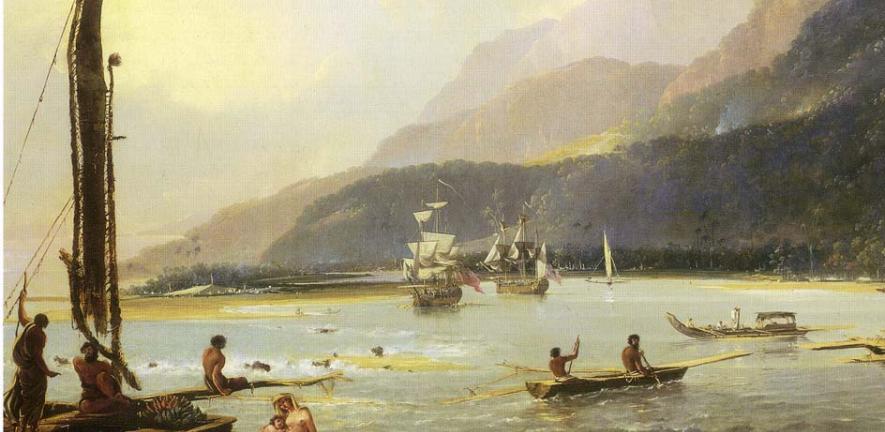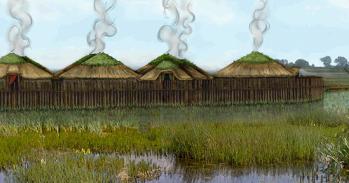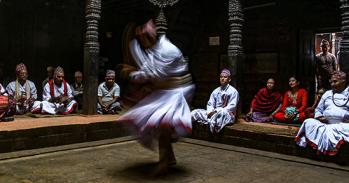
Islanders: The Pacific in the Age of Empire tells the story of the Pacific Islanders and their early interactions with Western travellers from the viewpoint of the Islanders themselves and sets the arrival of Westerners within a context of existing voyages within the region.
Islanders: The Pacific in the Age of Empire tells the story of the Pacific Islanders and their early interactions with Western travellers from the viewpoint of the Islanders themselves and sets the arrival of Westerners within a context of existing voyages within the region.
People have remained, in vital and intractable ways, themselves. Even when they work far from home in factories, or for peacekeeping missions, they are at once marked by worldliness and able to shrug it off.
Professor Nicolas Thomas
When a well-known travel magazine set out to identify the top ten travellers of all time, the names it came up with held few surprises. Top of its list, which encompassed Charles Darwin and Christopher Columbus, was Captain James Cook, the legendary British explorer. Cook’s voyages were extraordinary in their scope and ambition, but he was not the only person to have travelled widely in the Pacific.
A prize-winning book by Cambridge anthropologist Nicholas Thomas, Islanders: The Pacific in the Age of Empire looks at the remarkable journeys undertaken by the Pacific Islanders themselves. It is a narrative that begins with the voyages that led to islands as remote as Rapanui (Easter Island) and New Zealand being settled, and embraces the interactions of these Pacific peoples with the Europeans who followed centuries later. Thomas, whose own academic career has spanned the globe, examines not just the impact of colonial Europe on indigenous cultures but the ways in which the cultures of incomers have merged with those of the islanders – and vice versa – in a way that’s both complex and nuanced.
Though Cook was preceded in the Pacific by earlier Spanish, Dutch and British navigators, his were the voyages that inaugurated contacts with native peoples in many of the archipelagos. Seen through the traditional Western historical lens, his were the “discoveries”. Since the epoch of decolonisation, academics have sought to reconfigure this interpretation – presenting Islanders as active makers of their own histories, rather than merely victims. But most researchers have retained the tendency to see Islanders as the inhabitants of bounded native communities, rather than voyagers in their own right. It is this notion that the worlds of indigenous people were limited to the 'local' that Thomas has challenged, on the basis of wide-ranging archival work that has revealed the many and diverse voyages that Islanders themselves undertook.
Thomas was inspired to write Islanders by his understanding of the resilience and the unexpected cosmopolitanism of islanders' lives. That understanding emerged from two sorts of research experience – his fieldwork in the Pacific and his examination of archives around the globe. Both are underpinned by his lifelong fascination with the Pacific. “Ever since the 1980s I’ve been lucky enough to travel and do fieldwork in the Marquesas Islands, Fiji, Niue and elsewhere, talking to people, living among them, gaining some sense of their own understandings of history,” he says.“During research in Fiji, and in other places, I’ve been struck by the fact that life on the Pacific Islands is still a matter of exchange, debt and ceremony, even as it has become entangled with commerce and politics. People have remained, in vital and intractable ways, themselves. Even when they work far from home in factories, or for peacekeeping missions, they are at once marked by worldliness and able to shrug it off.”
The second strand running through the book is Thomas’s research in archives all over the world, from Europe to Australia and in the Pacific Islands themselves. “Sitting in libraries I’ve struggled through legible and indecipherable manuscripts, journals and memoirs of missionaries, traders, officials and anthropologists. – all have different biases, of course, but many of these records are surprisingly frank, and full of insights of all sorts - into the lives of Islanders in the past."
Missionaries, their lives, journeys and ambitions have always intrigued Thomas. Less than an hour from his office in Cambridge, where he is director of the University's Museum of Archaeology and Anthropology, are the archives of the London Missionary Society at the School of Oriental and Asian Studies. “As I read the letters and journals of figures such as John Williams - the most renowned missionary before David Livingstone - I was excited, indeed astonished, to gain a fresh sense of what was at issue in the Islanders’ adoption of Christianity. In fact, Islanders had sometimes embraced new cults more than once before. They did so for political reasons - to gain advantage in local struggles for prestige and authority - and would do so again when Christianity seemed a potent new resource. They went as far as to become missionaries themselves, spreading the word to communities other than their own, in advance of the white missionaries whose importance has been exaggerated.”
It’s tempting to perceive indigenous people as “locals”: people living in the middle of nowhere and going nowhere. “We see them as bounded communities who were impacted upon by Western civilisation in the shape of religion, commerce and government,” says Thomas. “But the experiences of the Pacific islanders had long been extra-local. They traded and trafficked among themselves and, when the Europeans arrived, they began to range more widely. There was cosmopolitanism to their practise and to their imagining.”Mission and shipping archives reveal that from the end of the 18th century onwards, many Islanders – especially in the early days – travelled extensively. They joined ships, typically as ordinary maritime workers, they visited ports all over the world, they travelled to many islands in the Pacific, sometimes settling and sometimes returning home.
Perhaps the most striking among the great travellers of the Pacific, and the one that most captures Thomas’s imagination as a Polynesian Odysseus, is a man named Tapioi who left Tahiti on the first day of the 19th century and visited Australia, New Zealand, Tonga, Palau, the Philippines, the East Indies, England and other places. Though all but lost to history, his life offers a lens on the extraordinary changes and new horizons that marked Pacific lives in the period.
Thomas first encountered Tapioi in the archives of the London Missionary Society archives and began to piece together his story from cursory newspaper references, letters and other records. It seems that a thirst for adventure may have motivated the young Tapioi to join a whaler called the Betsey and then another ship called the Plumo. His adventures read like the most fantastical of blockbusters with several shipwrecks, mutiny and imprisonment.
In 1806 Tapioi arrived in London on a trading ship. He fell into the clutches of a former missionary who was prosecuted for exhibiting him like a wild beast in the streets and abusing him. Taken in by another missionary, Tapioi was sponsored by a committee to attend a progressive Quaker school in Southwark where he became “acquainted with the laws of civilised society”. Four years later Tapioi was given a passage on a ship carrying convict women to Sydney. He was given carpentry tools and, because he was fond of drawing, drawing paper, pencils and a large box of colours”.
It may well be significant that Tapioi never returned to Tahiti: he settled on a farm near Sydney and died of dysentery or something similar in 1812. He was just 35, or perhaps slightly older. In Islanders Thomas writes of his frustration that so little remains of Tapioi’s extraordinary story and his encounters with people all over the world. "It would be remarkable to understand how this man understood the extraordinary diversity of places he visited and peoples he encountered,” he writes.
From the late 18th century onwards Europeans made incursions into the Pacific, some seeking to profit from commerce, others to change Islanders' lives and save their souls. Sandalwood was highly prized for its essential oils, used in soaps and fragrances, and beche de mer (sea cucumber) as an edible delicacy, much favoured in south-east Asia. Conversion to Christianity was seen as a matter of urgency by the evangelically-minded.
The Western characters whose stories are interwoven with those of the Pacific islanders are larger-than-life. Among them are the fervent young Northamptonshire shoemaker William Carey, an evangelical autodidact who drew up a statistical table of the “heathens” in “barbarous nations” who must be systematically converted to Christianity, and the bricklayer George Vason who married into Tongan royalty, took on the status of a chief, and wrote later of his lamentable period of “declension”, while signally failing to conceal his delight in Tongan customs and the island’s idyllic natural environment.
Fascinating too are the ragtag collection of Westerners who ended up through shipwreck, mutiny or misadventure on far-flung shores – precursors perhaps of today’s hippies and drop-outs. Thomas calls them beachcombers, a human version of flotsam and jetsam, riding on the ebb and flow of life’s tides. An ability to speak the local language, and understand the local culture, made them useful, but not always trusted, as interpreters in negotiations between mariners and locals.
Islanders is a work that draws together a lifetime of research. It touches on some deep questions and tells of the tragedies that occur when human interactions go badly wrong. Westerners brought with them diseases that, according to varying estimates, reduced the population of the Pacific by half in many cases, and as much as 90 per cent in the worst. On one occasion a group of missionaries, attempting to address people in Tahiti, found themselves competing with a speech from a man “employed in enumerating the diseases the English have brought here…they were all dying, and but a few left alive.” Yet, despite this real devastation, Islands cultures remained resilient, and are very much alive today.
Islanders: the Pacific in the Age of Empire by Nicolas Thomas is published by Yale University Press. It won the 2010 Wolfson History Prize.
This work is licensed under a Creative Commons Licence. If you use this content on your site please link back to this page.





